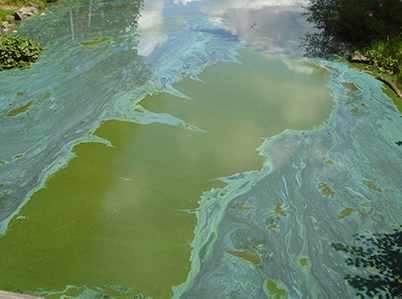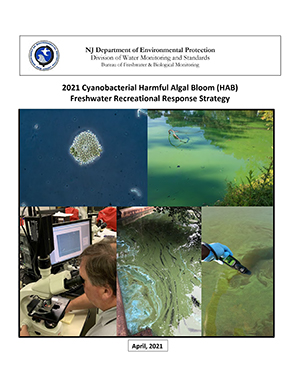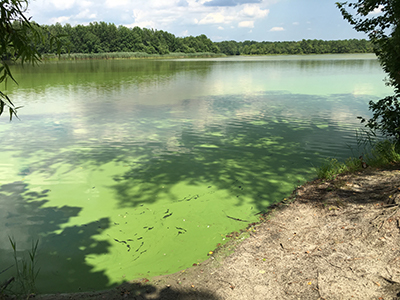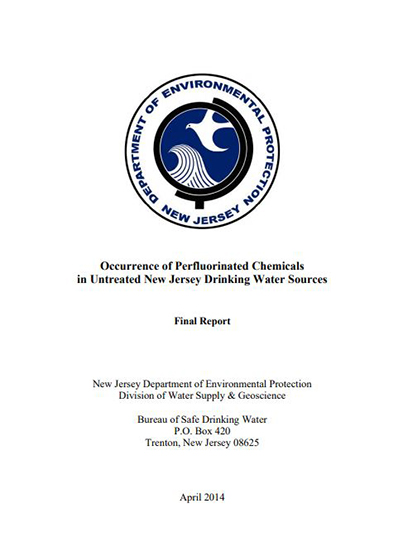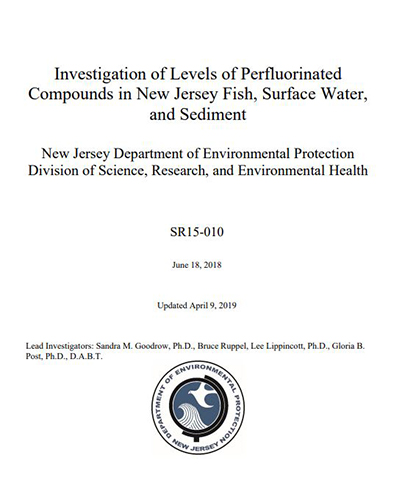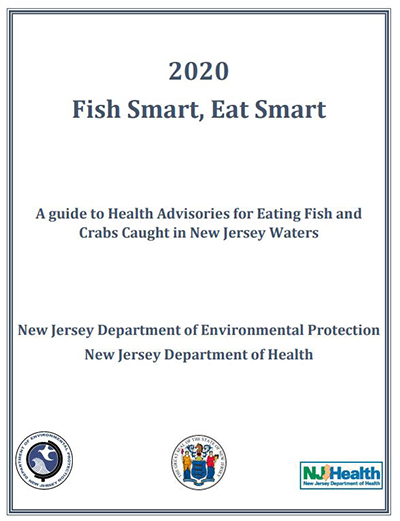
NJ Integrated Water Quality Assessment Report 2022 – State Concerns/Recommendations
Clean Water Act 303(d) List & 305(b) Report
Impacts of Climate Change on Water Quality
| Potential Impact | Anticipated Effect on Water Resources |
|---|---|
| Changes in Temperature: | Changes in the distribution and survival of aquatic species, algal blooms, and lower dissolved oxygen levels |
| Changes in Precipitation: | • Reduced groundwater and surface water supply in some areas • Reduced reliability of snow pack to replenish reservoirs and aquifers • Droughts • Wildfires • Increased water demand due to higher temperatures • Increased runoff resulting in erosion and sedimentation |
| Increases in Storm Intensity: | • Contaminated Waters • Damaged Wetlands • Flooded Wastewater Treatment Plants • High Wind Damage |
| Sea Level Rise: | • Displacement of coastal wetlands and habitat • Increased coastal erosion • Salt water intrusion in drinking water supplies • Inundation of wastewater treatment infrastructure |
| Ocean and Coastal Changes: | • Biological habitat changes as the air temperatures increase • Estuarine waters become more saline as sea levels rise • Ocean temperatures increase • Ocean acidification |
In 2020, the DEP led a comprehensive effort to synthesize the latest and most reliable scientific information on the current and predicted future impacts of climate change on the state. According to the report, New Jersey has seen evidence of climate change in its increasingly mild winters, more intense rainfalls, flooding along inland streams and rivers, and more tidal flooding along the coast. These events can threaten public health and safety, destroy property, undermine critical infrastructure, and damage New Jersey’s economy, including the vibrant tourism industry. As New Jersey’s Scientific Report on Climate Change explains, data indicates that as atmospheric levels of carbon dioxide and other greenhouse gases increase, New Jersey will experience significant direct and secondary changes in its environment. These include increases in temperature, variability in precipitation, frequency and intensity of storms, sea-level rise, ocean acidification and the associated impacts to ecological systems, natural resources, built environments, human health and the economy.
One of the areas of focus was water quality and quantity. Climate impacts on these are such that:
- Periods between rain events may be longer, causing drought conditions more frequently, increasing potential for reduced water supply availability, reductions in agricultural capacity that lead to shortages in food production and increased prices, and economic loss from impacts to livestock, and reductions in hydroelectric power production.
- New Jersey’s agricultural yields could suffer as water supplies are stressed from an expanded growing season, while some crops may not thrive in warmer temperatures.
Climate change implications for water resources are complex. Higher temperatures will increase evaporation (from surfaces) and transpiration (from plants), as will a longer growing season. Stream flows rely heavily on flows from ground water, which in turn rely on recharge rates that could change either for the better (in response to more precipitation and longer frost-free periods) or for the worse (in response to competition from vegetation during a longer growing season, and more precipitation going to runoff due to more intense storms). While more precipitation is possible, more frequent short droughts are as well. Increased temperatures also change water chemistry and quality, as will more severe storms, complicating the protection of water supplies. The net effect is likely to be a greater variability in water availability. Improved management approaches will be needed to ensure sufficient supply of sufficient quality. Water supply management should be based on projected scenarios, not a repeat of past conditions, and additional research on the implications of hydrologic changes will be needed, with the results linked back into the scenario development process.
Harmful Algal Bloom (HAB) is the name given to the excessive growth or “bloom” of cyanobacteria which can produce one or more types of potentially harmful toxins. HABs can occur in fresh and marine water under suitable environmental conditions of sunlight, temperature, nutrients, and calm water. These “blooms” often result in a thick coating or “mat” resembling pea soup or spilled paint on the surface of a waterbody, often in late-summer or early fall. A HAB can be dangerous to people, animals or the entire ecosystem and some can produce chemicals that can be toxic to humans and animals if ingested, inhaled, or if contacted by skin or mucous membranes. The effects of any contact can include allergic reactions, gastroenteritis, rash, flu-like symptoms, and other irritations. There is limited information whether these toxins can accumulate in fish and shellfish. However, it is cautioned to not consume fish or shellfish when a HAB is present.
DEP has developed the capacity to perform enhanced monitoring and analysis of these toxins as well as response strategies for advisories and actions in both freshwater and marine water. For freshwater, observed blooms undergo a field screen with a handheld fluorometer or microscopic confirmation. Once the presence of cyanobacteria is determined, additional samples are collected for the laboratory and a monitoring plan will be implemented for that site. DEP recently published the “New Jersey Cyanobacterial Harmful Algal Bloom (HAB) Response Strategy”, that provides a statewide approach to responding to cyanobacterial HABs in freshwater recreational waters and sources of drinking water.
In marine waters, the DEP’s Algal Bloom Monitoring Program has been conducting phytoplankton monitoring to ensure safe shellfish harvesting. There are two components to the monitoring program including phytoplankton monitoring at fixed station and aircraft remote sensing for chlorophyll during the summer. The fixed monitoring network gives a representative overview of the estuarine waters of New Jersey and 45 stations are sampled year-round for HABs. The aircraft remote sensing conducts six flights a week and identifies algal blooms in coastal waters.
When areas of concern are detected, samples are then taken to determine if cyanobacteria are present. As part of the State’s compliance with the National Shellfish Sanitation Program (NSSP), DEP is required to develop a Biotoxin Contingency Plan that includes control measures for marine biotoxins.
DEP has employed the use of continuous monitoring buoys in Lake Hopatcong and Manasquan River. An additional 10 buoys will be installed in Spring 2021 at assorted lakes, in addition to our seasonal lake flights to collect additional information in the formation of recurring blooms.
Over the last several years, DEP has made significant strides in understanding HABs, educating the public and developing tools to address these blooms. This information may be found on the DEP’s website at the link below.
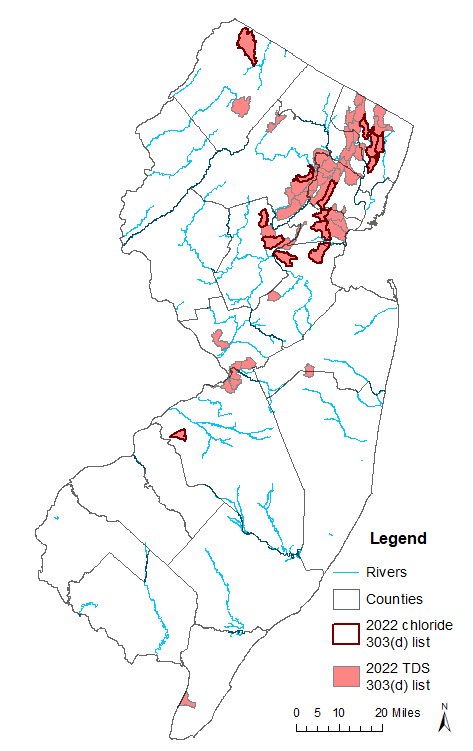
Long-term water quality monitoring data show a trend of increasing chloride and total dissolved solids (TDS) concentrations in NJ surface waters. Elevated chloride and TDS directly impact aquatic life (including macroinvertebrates, fish, and amphibians) and human health, while chloride can also indirectly affect human health by increasing water corrosivity that can lead to unhealthy levels of metals in drinking water.
TDS and chloride increases are associated with runoff from urban and agricultural areas as well as discharges from wastewater treatment facilities and septic systems. In the winter, runoff of salt used to control ice on roadways can be a serious problem, and NJ’s salt use for road deicing is growing.
Data from the DEP’s year-round Ambient Surface Water Quality Monitoring Network (ASWQM) show increasing trends in median concentrations of dissolved chloride and TDS. The number of samples which exceed New Jersey’s surface water quality standards (SWQS – N.J.A.C. 7:9B) for chloride and TDS is also increasing. Most of the concentration increases (73% of TDS samples over 500 mg/L and 82% of chloride samples over 230 mg/L) occur in our cold weather months (November through April) in the 2022 10-year data results. The data reviewed to develop NJ’s Integrated Report identified 52 assessment units with use impairments due to exceedances of SWQS for TDS and 14 assessment units with use impairments due to chloride in the 2022 list. TDS and chloride impairments have increased from 39 and 8 assessment units, respectively, in the 2020 Integrated Report. Most of the impaired assessment units are in the Piedmont physiographic region and have relatively high levels of impervious surface, although the increasing TDS and chloride trends were found in all areas.
NJDEP Continuous Specific Conductivity Monitoring Project
Specific conductance (which correlates with the sum of dissolved major ion concentrations in water) is strongly correlated to TDS and chloride, and easily and accurately measured in the field. Beginning in 2011, NJDEP deployed continuous specific conductance data loggers to over 50 non-tidal freshwater stream sites with varying levels of urbanization. Continuous specific conductance data showed substantial increases with significant snowfall events. Based on these recordings, winter levels are much higher than previously thought and the continuous data identified peaks and durations of elevated chloride and TDS concentrations.
Management of Road Salt Impacts
The DEP’s municipal stormwater regulation program includes required and recommended best management practices in the MS4, Public Complex, and Highway Agency permits that aim to reduce the impact of deicing materials. Required measures include good housekeeping, proper storage of liquid and bulk deicers, street sweeping, management of excess deicing materials, and employee training. In addition, the DEP has a Snow Removal and Disposal Policy that prohibits the dumping of snow in waterbodies, wetlands, stormwater basins etc. except with an emergency permit from the DEP. A Water Quality Restoration Program grant awarded to Brick Township Municipal Utilities Authority aims at reducing road salt impacts, through development of a winter road de-icing best management practices report, workshop, and pilot municipal demonstration project.
Currently, the DEP is compiling road salt usage and loading trends and reviewing other states’ approaches to reduce road salt impacts, including TMDLs and BMPs. These efforts will be in the DEP’s technical and implementation approach to further address this water quality problem.

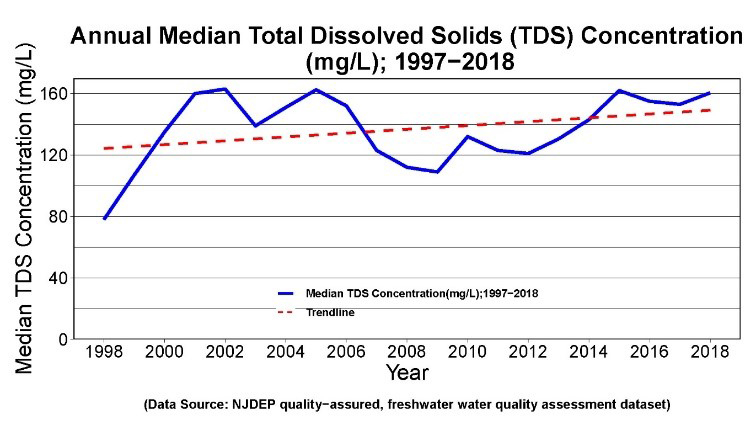
Per- and polyfluoroalkyl substances, or PFAS, are a large family of thousands of manmade chemicals that have been used in industrial and commercial applications for over 70 years. Their useful properties including repelling water and oil and resistance to heat and chemical reactions. PFAS are also known as “forever chemicals” because of their extreme resistance to degradation.
PFAS are used in products including stain-resistant coatings for upholstery and carpets, water-resistant breathable clothing, greaseproof food packaging, cosmetics, and Class B aqueous film-forming foam (AFFF) used for extinguishing hydrocarbon fires and in firefighter training. They are also used in industrial processes such as the manufacture of fluoropolymers used in non-stick cookware and other products and in metal plating and finishing.
PFAS can enter the environment through wastewater discharge or air emissions from industrial facilities where they are made or used, release of AFFF during training or firefighting, land application of biosolids (sludge) and discharge of effluent from wastewater treatment plants, and in leachate from landfills where industrial waste or consumer products containing PFAS are disposed.
Many PFAS, particularly those with long carbon chains (e.g., perfluorooctanoic acid [PFOA], perfluorooctane sulfonate [PFOS], and perfluorononanoic acid [PFNA]) bioaccumulate in humans, persist in the body for many years after exposure ends, and are linked to adverse health effects. Short chain PFAS such as GenX (a replacement for PFOA), while less bioaccumulative, often cause the same types of toxicity as the long chain PFAS that they replace.
PFAS are frequently detected in various environmental media in New Jersey, including drinking water using surface water and groundwater sources, ambient groundwater and surface water, and fish, and they may pose serious threats to wildlife and humans. New Jersey was the first state to evaluate the occurrence of PFAS in drinking water in studies conducted in 2006 and 2009-10. Extensive additional drinking water occurrence data were obtained through the USEPA Unregulated Contaminant Monitoring Rule 3, which required testing for six PFAS in finished water at all large (>10,000 users), and a subset of small, public water systems nationwide, as well as from the MCL compliance monitoring now required of all New Jersey community and non-transient non-community water systems. Additionally, PFAS monitoring in New Jersey’s ambient groundwater and surface water networks has been conducted and is ongoing. A study of PFAS in fish tissue, sediment, and surface water found that certain PFAS, including PFOS and perfluoroundecanoic acid (PFUnDA), commonly accumulate to levels of concern in fish caught in New Jersey; a second phase of this study in additional waterbodies is ongoing. Additionally, DEP scientists, in collaboration with a local municipal utilities authority, conducted a trackdown study to identify the source of PFOA, and other PFAS in the Metedeconk River, which is used as a drinking water source.
Although the production of long-chain PFAS such as PFOA, PFOS, and PFNA in the U.S. has ceased, contamination is expected to continue indefinitely because these PFAS are extremely persistent in the environment and are soluble and mobile in water.
Along with the study of these pollutants, NJ became the first state to establish a drinking water standard for PFAS chemicals in 2018. Most recently, NJDEP adopted
To address detections of PFAS at levels of concern in New Jersey’s environment, DEP has established standards or advisories for PFAS in several environmental media. NJDEP adopted the first drinking water standard in the U.S. for any PFAS when it established a maximum contaminant level (MCL) for perfluorononanoic acid (PFNA) in 2018, and it also adopted a ground water quality standard for this contaminant in 2018. This was followed by the adoption of MCLs and ground water quality standards for perfluorooctanoic acid (PFOA) and perfluorooctane sulfonate (PFOS)in 2020. These three PFAS, as well as GenX are now also regulated in soil at sites undergoing remediation. NJDEP also regulates another type of PFAS, chloroperfluoropolyether carboxylates (ClPFPECAs), in groundwater. ClPFPECAs were used at a New Jersey industrial facility and have been detected in the multiple environmental media, including groundwater, in the state. Additionally, DEP anticipates proposal of the PFOA, PFOS, and PFNA MCLs as freshwater human health criteria in proposed updates to the DEP Surface Water Quality Standards. NJ-specific bioaccumulation factors (BAFs) that describe the accumulation of PFAS in aquatic organisms are under development for use in future consideration of the fish consumption pathway in human health criteria for both freshwaters and saline waters.
To address detections of certain PFAS, particularly PFOS, at levels of concern in fish caught in New Jersey, the state has issued fish consumption advisories for certain waterbodies based on the concentration of these chemicals found in the fish tissue (DEP 2021: Fish Smart, Eat Smart). Sampling for PFAS in the routine monitoring program is currently being expanded to understand how widespread this contamination is in fish species in NJ.
Within DEP, several programs are investigating releases of PFAS into our environment. They are working on remediating contaminated areas and reducing these releahttps://njdepwptest.net/wp-content/uploads/dsr/fish-advisories-2021.pdfses at the source. DEP is surveying the regulated community, enhancing PFAS monitoring and developing reporting and management approaches to protect human health and the environment. A potentially worthwhile pollutant reduction method, as has been applied for other persistent compounds, is to continue coordinated track-down of high contamination areas for isolation and pollutant removal from the environment.


